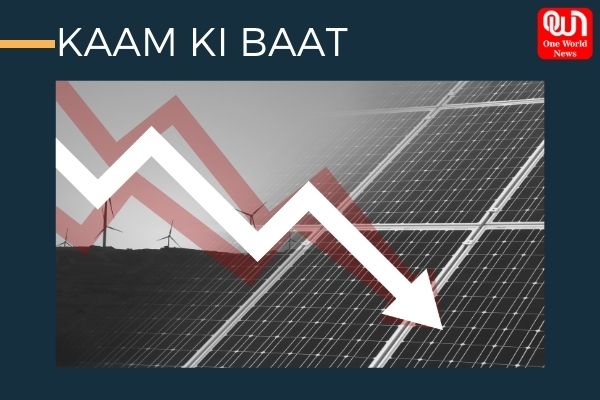
Impact of COVID-19 financial crunch on India’s goal to achieve 225 GW energy generation from renewable sources
The year 2020 has brought the world to a standstill due to the global pandemic. Many developmental works of several countries were put on halt due to the financial crunch created by the coronavirus lockdown. In this Kaam Ki Baat article, we will try to understand how India fared in the renewable power generation in the year 2020.
Renewable power generation in India
According to BP’s Statistical Review of World Energy, India’s primary energy consumption hit 809.2 million tons of oil equivalent in 2018. Based on this metric, India is behind only to China and the US.
By January 2020, India’s installed capacity of all energy sources stood at 369GW. 86.3 GW of this total energy generation came from renewable energy sources – solar, wind, hydro and bio-power. The renewable power generation increased to 88.79 GW by August 31, 2020, of which the solar energy contributed 35.73 GW and wind energy contributed 37.99 GW. Hydropower and Biomass contributed 4.73 GW and 10.14 GW respectively. India’s power generation from renewable energy sources touched 127.01 billion units in the financial year 2020.
India has set an ambitious target of 225 GW of renewable energy generation (114 GW of solar capacity and 67 GW of wind capacity) by the year 2022, a goal proudly displayed on the official website of Ministry of New and Renewable Energy. It is more than 175 GW target, decided as per the Paris Agreement. India is aiming to establish the capacity to generate a total of 500 GW renewable energy by the year 2030.
India’s installed renewable power generation has increased over the past few years, posting a compound annual growth rate of 17.33 per cent between the financial year 2016-20. The sector has become attractive for investors due to increased support of the government and improved economics.
India had issued wind power projects worth 15,100 megawatts (MW) by December 2019 in which projects of 12,162.50 MW capacity has already been awarded. In the year 2019, we installed 7.3 GW of solar power across the country and became the third-largest solar market in the world. With policies focused on the renewable energy sector, Northern India is expected to become the hub for renewable energy in India.
Read more: Biggest Diplomatic achievements of India in 2020 that shows India’s increasing power
Government initiatives to boost India’s renewable energy sector
The government announced plans to offer land near its ports to companies for establishing solar equipment factories in August 2020. The Delhi government led by Arvind Kejriwal decided to shut down a thermal power plant in Rajghat and develop it into a 5,000 KW solar park.
Rajasthan government in its 2019-20 budget, decided to give exemption to solar energy from electricity duty and focused on the utilization of solar power in its public health and agriculture sectors.
Indian government drafted a new Hydropower policy for 2018-28 for the growth of hydro projects in the country. The central government also announced plans to implement a $238 million National Mission on advanced ultra-supercritical technologies for cleaner coal utilization.
The Ministry of New and Renewable Energy has provided custom and excise duty benefits to the solar rooftop sector, which will lower the cost of generating power and setting up a solar power unit, which will ultimately boost growth.
Indian Railways is also doing its bit towards a cleaner energy through sustained energy efficient measures and maximum use of clean fuel to cut down level of emission by 33 per cent by 2030.
India has also planned to add 30 GW of renewable energy capacity along a desert on its western borders such as Rajasthan and Gujarat.
Coronavirus impact on the renewable power generation
As per the reports of IEA, India found difficulties in distributing utilities as the pandemic hit our financial viability. This financial instability led to delayed payments to generators which lowered the profitability of existing projects and raised the level of risk perceived by financial institutions and potential developers.
Total overdue payments owed by utilities rose 10 per cent for renewable electricity plants and 28 per cent for all electricity generators. India announced an extensive loan programme in May 2020 to reduce overdue amounts owed to generators.
As per the data of Central Electricity Authority, India’s power generation from renewable energy sources grew 9.46 per cent in January 2020 in comparison to January 2019. A total of 10.325 billion units were generated in January 2020, which was 9.433 billion units in January 2019.
CEA report suggested that India’s total power generation from both renewable energy sources and conventional sources grew 2.65 per cent to 113.20 billion units in January 2020 from 110.280 billion units in January 2019.
Due to the COVID-19 pandemic, renewable energy has been resilient due to the economic shock. Wind capacity additions are expected to drop around 60 per cent in the year 2020 in comparison to 2019 which generated 1 GW. In the first half of 2020, nearly 0.3 GW wind capacity was added and only one wind auction took place in the first eight months.
India’s solar power generation capacity additions are forecasted to be third lower in 2020 than in 2019. Generally, the annual construction activity in India takes place in the first half of the year before the arrival of monsoon.
New photovoltaic (PV) capacity installations were 70 per cent below average in the year 2020 in comparison to first-half growth of the last three years. It is said that new coronavirus related supply chain disruptions, increased macro-economic risks and construction slowdowns were reasons behind the low average of new PV capacity installations.
However, the country is expected to bounce back in the year 2012 and 2022 as capacity additions are expected to increase more than of 2019 level and new projects are expected to become operational.
As per the International Energy Agency’s new report, Renewables 2020 – Analysis and forecast to 2025, India can contribute the most towards pushing the sector up in 2021. The agency has predicted that India will double its green energy capacity additions next year from 2020 levels. Many auctioned solar and wind photovoltaic projects are expected to become operational which were delayed due to COVID-19 challenges like acquiring lands and negotiating contracts.
Way forward for India
The IEA report highlighted that India’s innovation in the renewable energy sector to switch from state-level to central reverse-bid auction move will provide more payment and attract more competition. Despite the pandemic disruptions, India auctioned 8.2 GW of new photovoltaic capacity by September 2020. It exceeds the previous year’s number.
Other innovations such as wind-solar-storage hybrid auctions also make renewables more competitive. Removal of low-bod ceilings has allowed developers to fully reflect changes in the economic environment on their secure sustainable revenues and bids. Issues of land acquisition and transmission grid bottlenecks are being addressed through interventions of solar parks and Green Energy Corridors.
To reduce off-taker risks and find a sustainable solution to the financial challenges, India needs to reduce off-taker risks. It needs to introduce transparent, comprehensive and investor-friendly rules for signing private power purchase agreements and open grid access that could increase investment apart from the auction system.
Have a news story, an interesting write-up or simply a suggestion? Write to us at info@oneworldnews.com








